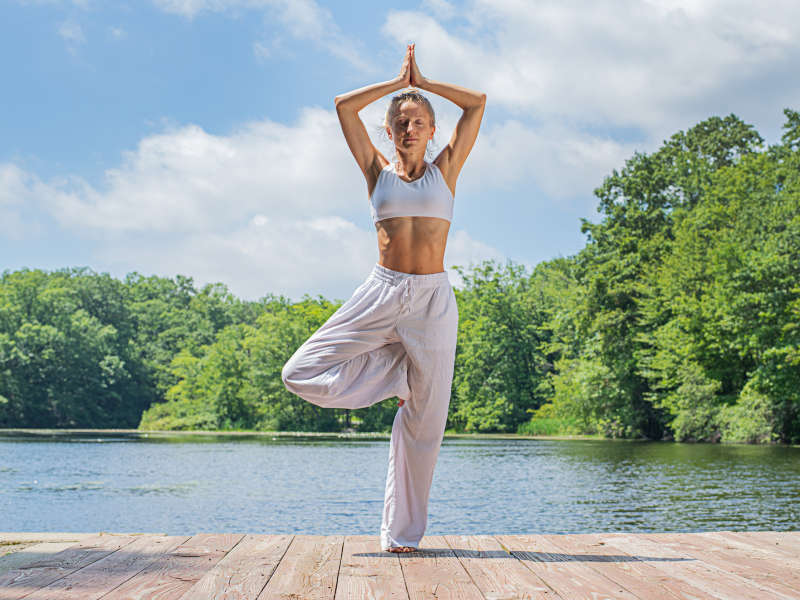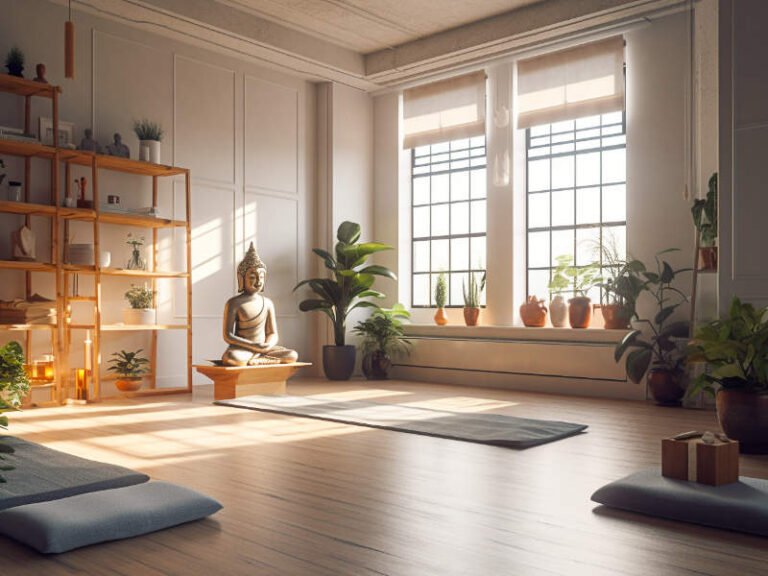
Pain-Free Living: Yoga Solutions for Conquering Chronic Pain
Chronic pain, an unwelcome companion for millions of people worldwide, casts a shadow over daily life and robs individuals of the simple pleasures they once enjoyed.
This persistent discomfort, often lasting for months or even years, can feel like an insurmountable obstacle in the quest for a balanced and fulfilling life.
But there is hope, as more and more people are discovering the transformative power of yoga in their fight against chronic pain.
The ancient practice of yoga is a holistic approach that integrates mind, body, and spirit in the pursuit of well-being.
Yoga offers a gentle yet powerful path to pain relief, enabling individuals to reclaim control over their bodies and their lives.
Drawing on centuries of wisdom, this time-tested discipline offers an effective solution for those seeking to conquer chronic pain and rediscover the joy of living.
As we embark on this journey together, let us remember that, in the words of Beryl Bender Birch, “Yoga is not about touching your toes, it’s about what you learn on the way down.”
In this article, we will explore the many ways yoga can help alleviate chronic pain and enhance overall well-being.
By integrating breathwork, mindfulness, and carefully selected asanas (yoga poses), you can create a tailored practice that supports your unique needs and fosters a deep sense of inner peace.
Ready to Step Into Your Power?
Unlock the clarity & wisdom that illuminates your path to a conscious, radiant life
Join the Wholebeing Newsletter Today!
By signing up, you agree to receive our well-being emails, special offers, and agree to the Privacy Policy. You can unsubscribe at any time.
Understanding Chronic Pain
Definition of Chronic Pain
Before we delve into the healing potential of yoga, it’s essential to grasp the nature of chronic pain and the complexities that surround it.
Chronic pain, as the name suggests, is a prolonged discomfort that persists even after the initial injury or cause has healed or subsided.
Unlike acute pain, which typically lasts for a short period and signals that something is wrong, chronic pain lingers and becomes a condition of its own, often lasting for three to six months or longer.
As Beryl Bender Birch reminds us once again, “It is not the destination that is important, but rather the journey itself.”
In the case of chronic pain, this journey can be both challenging and frustrating, as the source of the pain may not always be apparent, and the path to healing is rarely straightforward.
But by understanding the intricacies of chronic pain, we can better navigate the twists and turns of this journey and emerge stronger, more resilient, and more in tune with our bodies and minds.
Common Causes & Types of Chronic Pain
Chronic pain comes in many shapes and forms, manifesting as a result of various causes and conditions.
As we journey through life, we may encounter different types of chronic pain, each presenting its own set of challenges and opportunities for growth.
In the realm of yoga, depth and flexibility are not the ultimate goals; rather, it’s the insights and self-awareness we gain along the way that truly matter.
Similarly, when it comes to understanding chronic pain, it’s crucial to recognize the unique experiences that individuals face and appreciate the strength and resilience they embody.
Some common causes and types of chronic pain include:
Musculoskeletal Pain – This type of pain affects the muscles, ligaments, tendons, and bones, and can be caused by various factors such as injuries, overuse, or inflammation. Common examples include lower back pain, osteoarthritis, and fibromyalgia.
Neuropathic Pain – Originating from damage or dysfunction within the nervous system, neuropathic pain often presents as burning, tingling, or shooting sensations. Conditions such as diabetic neuropathy, sciatica, and postherpetic neuralgia are typical examples of neuropathic pain.
Headaches & Migraines – Chronic headaches and migraines can be debilitating, affecting one’s ability to function in daily life. Tension headaches, cluster headaches, and migraines are all examples of chronic pain related to the head.
Visceral Pain – Arising from the internal organs, visceral pain can be caused by conditions such as irritable bowel syndrome, endometriosis, or interstitial cystitis.
As we explore the world of yoga and its potential to help manage chronic pain, it is important to bear in mind that each person’s experience is unique.
Nurturing compassion and understanding for ourselves and others enables us to create a supportive environment where true healing and transformation can take root.
How Chronic Pain Affects Overall Well-Being
Chronic pain is not merely a physical sensation; it has the power to permeate every aspect of our lives, impacting our emotional, mental, and spiritual well-being.
Just as yoga teaches us to seek harmony and balance in our practice, it is essential to recognize the interconnectedness of our whole being when addressing the challenges of chronic pain.
Living with chronic pain can lead to a variety of consequences that ripple outwards, touching multiple dimensions of our lives:
Emotional Health – The persistent nature of chronic pain can be emotionally taxing, leading to feelings of frustration, anger, sadness, or even depression. This emotional strain may further exacerbate the experience of pain, creating a vicious cycle that is difficult to break.
Mental Health – The constant struggle with pain can be mentally exhausting, affecting one’s ability to concentrate, remember, or think clearly. Over time, this may result in increased stress, anxiety, and a diminished sense of self-worth.
Social & Relational Well-Being – Chronic pain can also strain relationships and limit social interactions, as individuals may withdraw from their loved ones or avoid activities they once enjoyed. This social isolation can lead to feelings of loneliness and disconnection.
Spiritual Health – When faced with the ongoing challenge of chronic pain, individuals may question their sense of purpose, grapple with feelings of hopelessness, or experience a loss of faith in their spiritual beliefs.
In the practice of yoga, we learn to approach our experiences with a sense of curiosity, non-judgment, and self-compassion.
Applying these principles to our understanding of chronic pain, allows us to acknowledge its impact on our whole being and seek out holistic approaches to healing that foster harmony, balance, and a deep sense of inner peace.

Brief History of Yoga & its Origins
Yoga is deeply rooted in ancient wisdom, and has evolved and flourished over thousands of years, offering insights and techniques for harmonizing body, mind, and spirit.
Originating in India more than 5,000 years ago, yoga began as a philosophical and spiritual discipline, with an emphasis on meditation, breathwork, and ethical principles to guide daily life.
Over time, the practice of yoga expanded to include physical postures, or asanas, which were designed to help practitioners prepare for meditation by cultivating strength, flexibility, and balance.
As yoga traveled beyond India’s borders, it adapted to the diverse cultures and traditions it encountered, giving rise to numerous styles and approaches that emphasize different aspects of the practice.
Today, yoga is widely recognized for its profound healing potential, serving as a bridge between ancient wisdom and modern science.
As we explore yoga in terms of chronic pain, we are reminded that the practice is not merely about physical prowess or flexibility; rather, it is a holistic journey towards self-awareness, well-being, and inner harmony.

The Mind-Body Connection in Yoga
One of the most powerful aspects of yoga lies in its ability to foster a strong mind-body connection.
This interconnectedness is at the heart of the practice, inviting us to cultivate greater self-awareness, presence, and balance within ourselves.
In the realm of chronic pain management, the mind-body connection takes on a particularly important role, offering a path towards healing that acknowledges the intricate relationship between our physical sensations and our emotional and mental well-being.
Yoga encourages us to tune into our breath, thoughts, and bodily sensations with curiosity and non-judgment.
By grounding ourselves in the present moment, we learn to navigate the fluctuations of our minds and the sensations within our bodies with greater ease and resilience.
This heightened sense of awareness enables us to recognize and respond to the signals our bodies send, empowering us to make choices that support our overall well-being.
In the context of chronic pain, the mind-body connection cultivated through yoga has been shown to help reduce pain intensity, increase pain tolerance, and improve overall quality of life.

Key Yoga Principles for Chronic Pain Relief
The Importance of Breathwork
Breath, often referred to as the life force or prana in yogic philosophy, is a vital component of the yoga practice, serving as a powerful bridge between our bodies, minds, and spirits.
The practice of breathwork, or pranayama, invites us to explore the intimate relationship between our breath and our overall well-being, guiding us towards greater self-awareness, balance, and harmony.
For those living with chronic pain, breathwork holds particular significance.
Learning to harness the power of our breath, allows us to tap into our body’s innate capacity for relaxation, stress reduction, and healing.
Deep, conscious breathing activates the parasympathetic nervous system, which is responsible for our body’s rest and digest response.
This activation can help to counteract the stress and tension often associated with chronic pain, promoting relaxation, easing muscle tightness, and reducing pain perception.
Moreover, breathwork encourages us to remain present, fostering a greater sense of mindfulness and self-compassion.
By directing our attention to our breath, we can anchor ourselves in the present moment, cultivating the ability to observe our pain without becoming consumed by it.
This increased mindfulness enables us to approach our pain with curiosity, patience, and loving-kindness, transforming our relationship with chronic pain and empowering us to find a greater sense of ease and freedom in our daily lives.
Mindfulness & Being Present
At its core, yoga is a practice of mindfulness, inviting us to engage fully with the present moment, both on and off the mat.
Through the cultivation of mindfulness, we learn to observe our thoughts, emotions, and bodily sensations with non-judgmental awareness, opening ourselves up to a deeper understanding of our true nature and the interconnectedness of our experiences.
When it comes to chronic pain relief, mindfulness and being present hold particular importance.
Pain, by its very nature, can be all-consuming, causing us to become lost in thoughts of the past or anxieties about the future.
Grounding ourselves in the present moment, gives us the ability to step back from the stories our minds create around our pain, recognizing that these narratives are not our reality, but merely passing thoughts.
As we learn to approach our pain with mindfulness and presence, we develop the ability to respond to our experiences with greater clarity, compassion, and resilience.
Rather than resisting or avoiding our pain, we can begin to embrace it as a teacher, an opportunity for growth and self-discovery.
Embracing Self-Compassion & Non-Judgment
Yoga teaches us to approach our practice and ourselves with a sense of self-compassion and non-judgment.
These principles remind us that our journey is not about striving for perfection or rigidly adhering to external standards, but rather about cultivating a deep sense of love, acceptance, and kindness towards ourselves.
For those living with chronic pain, embracing self-compassion and non-judgment can be a transformative experience.
Often, pain can lead us to judge ourselves harshly, feeling frustration or shame for our perceived limitations.
This self-criticism can further exacerbate our pain, creating a cycle of suffering that is difficult to break.
Applying the principles of self-compassion and non-judgment to our experiences with chronic pain, we can begin to release the burdens of self-blame and criticism, allowing ourselves the space to heal and grow.
As we learn to approach our pain with kindness and understanding, we recognize that our worth is not defined by our physical limitations, but rather by the wholeness and beauty of our authentic selves.

Recommended Yoga Poses for Pain Management
Gentle Stretches
1. Cat-Cow Stretch: This fluid, accessible movement helps to release tension in the spine, neck, and shoulders while promoting mobility and flexibility.
To practice Cat-Cow, begin on your hands and knees, with your wrists aligned under your shoulders and your knees aligned under your hips.
As you inhale, arch your back, lifting your chest and tailbone towards the sky, and gaze upwards (Cow).
On your exhale, round your spine, tuck your tailbone, and release your head, gazing towards your navel (Cat).
Continue to flow between these two movements with your breath, inviting a sense of ease and openness into your body.
2. Child’s Pose: A grounding, restorative posture, Child’s Pose offers a gentle stretch for the hips, thighs, and spine while encouraging relaxation and introspection.
To enter Child’s Pose, kneel on your mat with your knees hip-width apart and your big toes touching.
Sit back on your heels and fold forward, extending your arms in front of you and resting your forehead on the mat.
Breathe deeply, allowing your body to soften and release with each exhale.
3. Seated Forward Bend: This calming pose helps to lengthen the hamstrings and lower back while inviting a sense of introspection and surrender.
To practice Seated Forward Bend, sit on your mat with your legs extended in front of you. Inhale, lengthening your spine and reaching your arms overhead.
On your exhale, hinge at your hips and fold forward, reaching for your feet or legs.
Keep your spine long and your neck relaxed, and focus on deepening your breath as you surrender into the stretch.
Muscle Strengthening Poses
1. Bridge Pose: This rejuvenating pose strengthens the back, glutes, and hamstrings while opening the chest, shoulders, and heart.
To practice Bridge Pose, lie on your back with your knees bent and your feet hip-width apart, close to your sit bones.
Position your arms by your sides, ensuring that your palms are facing downward.
On an inhale, press into your feet and lift your hips towards the sky, engaging your glutes and thighs.
Keep your chin slightly tucked and your gaze upward, breathing deeply as you hold the pose for several breaths.
2. Warrior II: A powerful, grounding posture, Warrior II strengthens the legs, hips, and shoulders while fostering a sense of inner strength and resilience.
To enter Warrior II, step your feet wide apart on your mat, turning your right foot out and your left foot slightly inward.
Inhale as you raise your arms parallel to the floor, palms facing down.
Exhale and bend your right knee, aligning it over your right ankle.
Gaze over your right fingertips, maintaining a strong, steady breath as you hold the pose.
Repeat on the opposite side.
3. Tree Pose: A balancing pose that cultivates focus and stability, Tree Pose strengthens the legs, core, and ankles while improving posture and alignment.
To practice Tree Pose, stand tall with your feet hip-width apart.
Shift your weight onto your right foot, and gently place your left foot against your right inner thigh or calf, avoiding the knee.
Press your hands together at your heart or extend them overhead, and fix your gaze on a non-moving point in front of you.
Breathe deeply, finding stillness and balance within the pose. Repeat on the opposite side.
Restorative Poses
1. Legs-Up-The-Wall Pose: This deeply soothing pose allows for passive inversion, promoting relaxation, reducing swelling in the legs, and relieving tension in the lower back.
To practice Legs-Up-The-Wall Pose, sit sideways next to a wall with your right hip touching the wall.
Gently swing your legs up the wall as you lower your torso onto the floor, extending your arms out to your sides with your palms facing up.
Adjust your hips and legs as needed to find a comfortable position, and relax into the pose, breathing deeply and allowing gravity to do the work.
2. Reclining Bound Angle Pose: A gentle, nurturing posture, Reclining Bound Angle Pose opens the hips and chest while encouraging deep relaxation and introspection.
To enter the pose, lie on your back with your knees bent and the soles of your feet together, allowing your knees to fall open to the sides.
You may place cushions or folded blankets under your knees for support.
Rest your arms comfortably by your sides or place one hand on your heart and the other on your belly.
Close your eyes and breathe deeply, inviting a sense of surrender and release into the pose.
3. Corpse Pose: The quintessential restorative pose, Corpse Pose invites us to let go completely, finding stillness, peace, and integration at the end of our practice.
To practice Corpse Pose, lie on your back with your legs extended and your arms resting comfortably by your sides, palms facing up.
Allow your feet to fall open to the sides, and gently tuck your chin to lengthen your neck.
Close your eyes and take several deep, cleansing breaths before allowing your breath to return to its natural rhythm.
Surrender to the earth beneath you, releasing all effort and tension as you rest in the stillness and silence of the pose.

Tailoring Your Yoga Practice to Your Needs
Recognizing that each person’s journey with yoga is unique, it’s essential to adapt poses to meet your individual needs and experience level.
Beginners may choose to start with simpler variations of poses, gradually progressing to more advanced versions as they build strength, flexibility, and confidence.
Remember that yoga is not about competition or comparison, but rather about honoring your body and nurturing your personal growth.
To support your practice and make it more accessible and comfortable, particularly when dealing with chronic pain, props and modifications can be incredibly beneficial.
Blocks, straps, bolsters, and blankets can be used to support your body in various poses, allowing you to experience the benefits of each posture without strain or discomfort.
Experiment with different props and modifications to find what works best for your body, and don’t be afraid to get creative in your approach.
Perhaps the most critical aspect of tailoring your yoga practice to your needs is learning to listen to your body and respecting its limits.
Chronic pain can be unpredictable, and it’s crucial to approach each practice with an open mind and a willingness to adjust as needed.
If a pose doesn’t feel right or causes discomfort, give yourself permission to modify or skip it altogether.
Remember that your yoga practice is a tool for self-care and healing, and honoring your body’s wisdom is key to a fulfilling and transformative experience on the mat.

Integrating Yoga Into Your Daily Routine
Consistency is key when it comes to reaping the benefits of yoga for chronic pain management.
Carve out time in your daily routine to dedicate to your practice, even if it’s just a few minutes each day.
You might choose to practice in the morning to set a positive tone for the day or in the evening to unwind and release tension before bed.
Remember that your practice is a sacred time for self-care and healing, so approach it with intention, commitment, and compassion.
To further support your journey towards pain-free living, consider integrating yoga with other holistic therapies and practices that resonate with your needs and preferences.
Meditation, breathwork, and mindfulness techniques can enhance the mental and emotional benefits of yoga, while proper nutrition and hydration can nourish your body from the inside out.
Explore different modalities and approaches to find the combination that best supports your overall well-being and empowers you to conquer chronic pain with grace, resilience, and ease.

I hope my content sparks something deeper within: a moment of clarity, a gentle shift, or a deeply felt truth. Creating meaningful content takes time and heart. If you found value here, consider supporting my work to keep this space alive.
Vlad
Conclusion
As we’ve explored throughout this article, yoga offers a wealth of benefits for those seeking relief from chronic pain.
By nurturing the mind-body connection, fostering self-compassion, and embracing a holistic approach to wellness, yoga can be a transformative tool for managing pain and cultivating overall well-being.
From gentle stretches to strengthening poses and restorative postures, yoga provides a myriad of options to address the unique needs and experiences of each individual.
We invite you to embark on this journey of self-discovery and healing through the practice of yoga.
Embrace the wisdom of your body, explore the many facets of this ancient art, and integrate yoga into your daily routine as a powerful ally in your quest for pain-free living.
As you delve deeper into your practice, you’ll not only conquer chronic pain but also unlock your true potential for a life of balance, joy, and purpose.
Share the Love, Spread the Wisdom
You May Also Like:



